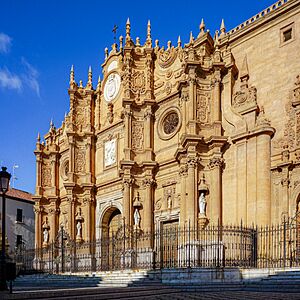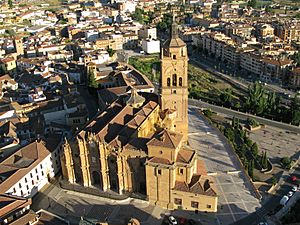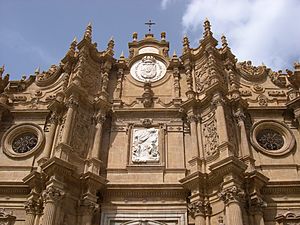Guadix Cathedral facts for kids
Quick facts for kids Guadix Cathedral |
|
|---|---|
| Cathedral of the Incarnation | |
| Catedral de la Encarnación | |

South façade
|
|
| 37°18′04″N 3°08′11″W / 37.3012°N 3.1363°W | |
| Location | Guadix |
| Country | Spain |
| Denomination | Catholic |
| History | |
| Former name(s) | Church of Saint Mary of the Incarnation |
| Authorising papal bull | 1492 |
| Status | Cathedral |
| Dedication | Incarnation |
| Architecture | |
| Architect(s) | Diego de Siloé, Francisco Roldán, Francisco Antero, Blas Antonio Delgado, Vicente Acero, Gaspar Cayón de la Vega, Fernández Pachote, and Domingo Thomas |
| Style | Gothic, Renaissance, Baroque |
| Years built | 16th—18th century |
| Specifications | |
| Length | 67 m (219 ft 10 in) |
| Width | 37 m (121 ft 5 in) |
| Tower height | 30 m (98 ft 5 in) |
| Bells | 13 |
| Administration | |
| Metropolis | Granada |
| Diocese | Guadix (since 1492) |
The Cathedral of the Incarnation (which in Spanish is Catedral de la Encarnación) is a big, important Roman Catholic church called a cathedral in Guadix, Spain. Building this amazing church started in the 1500s and finished in the mid-1700s. It is the main church for the Diocese of Guadix.
Contents
History of the Guadix Cathedral
Guadix is thought to have one of the oldest church areas, called a diocese, in Spain. People believe that Saint Torquatus of Acci started the diocese way back in the first century A.D. The cathedral stands where an older church used to be. This old church was there in the 900s and was even used as a mosque during the time of Islamic rule.
From Old Church to New Cathedral
During the Reconquista, which was when Christian forces took back land in Spain, Guadix was captured in 1489. The old church was then made into a main church for a bishop. It was named the Church of Saint Mary of the Incarnation. A special order from Pope Innocent VIII officially made it a cathedral. It was also made a bit bigger by Pedro de Morales.
Plans were made to build a new Gothic cathedral to show the victory of the Reconquista. However, by the time building started, the Gothic style was already old-fashioned. Important people like Cardinal Ávalos wanted a church that looked more modern. So, Diego de Siloé was hired in 1549 to design a new cathedral. He was inspired by the cathedrals in Málaga and Granada. Parts of the church, like the apse (the rounded end), part of the crossing (where the main parts of the church meet), and a chapel, were built following his plans.
Building the Cathedral: A Long Journey
Many architects worked on the new cathedral besides Siloé, including Francisco Roldán and Francisco Antero. Siloé designed the main chapel in a Renaissance style. This style used straight lines and curves, with lots of fancy decorations. Juan de Arredondo was the main builder.
The Freyla brothers, Pedro and Miguel, spent many years building a tall tower. This tower was meant to be a special symbol for the city.
In 1574, work on the cathedral stopped because there wasn't enough money. It didn't start again until 1594, when Bishop Juan de Fonseca y Guzmán helped get the project going again.
The building work got a new boost in the late 1600s and early 1700s with money from the king. Blas Antonio Delgado was put in charge of the new plans. He changed the design to make it look more horizontal. Delgado created the overall design for the cathedral, its different levels, the doors, and the cupola (a small dome). But in 1714, he had to move to Jaén.
Vicente Acero took over next. He changed the plans a lot before he also had to move. The city then asked Francisco de Hurtado Izquierdo for help. Instead of taking on the project himself, he suggested Gaspar Cayón de la Vega. Cayón de la Vega had a big impact on the later parts of the building. You can see his style in the vaulted ceilings, the dome, and the front part of the building, which has a lily design that Acero had started.
When Cayón de la Vega left for Cádiz in 1731, the front of the cathedral was still being built. Other architects like Vicente Acero, Pachote, and Thomas added parts that were not in Cayón's original plan.
Cathedral Architecture
Outside the Cathedral
The front of the cathedral is a wonderful example of Baroque architecture. It has two main parts and a tall top, with curved and wavy lines. The large middle section has two doorways, with groups of wide columns on each side. The top part was finished by Fernández Pachote and Domingo Thomas. Antonio Valeriano Moyano carved the marble statue of the Incarnation.
Inside the Cathedral
The chapel of Don Tadeo inside the cathedral shows strong Italian influences. It has a clever way of building arches within a round space. Another interesting part is the front of the sacristy (a room where priests prepare). It has a Renaissance style with a triangular top, decorative bands, and an arch between Corinthian columns. These columns feature the coats of arms of the city's bishops.
Bell Tower and Sacred Heart Statue
Building the bell tower started around 1559 and was finished in 1863. It has a square shape and is over 30 m (98 ft 5 in) tall, making it the highest structure in Guadix. You can climb to the top by going up 160 steps on a special double spiral staircase. At the top, there's a balcony that offers amazing 360-degree views of the city. It's open for visitors to enjoy.
On top of the tower is a 4.5 m (14 ft 9 in) tall statue of the Sacred Heart of Jesus. This statue was made by Amadeo Ruiz Olmo and put in place in 1945. The statue has a special feature: it slowly turns in 12-hour cycles. This turning mechanism was fixed in 2022 after being broken for many years. Also, a red light on its chest turns on every night after the sun goes down.
Images for kids
-
Replica of Michelangelo's Pieta
See also
 In Spanish: Catedral de Guadix para niños
In Spanish: Catedral de Guadix para niños








